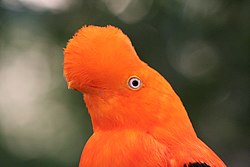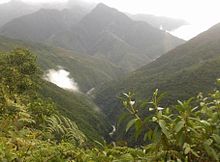El Choro Trek is in the La Paz department of Bolivia.
Understand
editHistory
editThe mainly well paved stone trail was constructed before or during the Inca Empire for the transport of food and goods from the lower subtropical area of the Yungas to the bigger cities in the mountains like today's La Paz.
Landscape
editLa Cumbre, the starting point of the trek, is a very high and cold place with a few small plants and a rocky landscape. Climbing up to the highest peak of the trail, you might experience snow and strong wind. From that point on the trail goes down into a valley, where you have a humid, softer climate. There are more and more plants, and after some hours you see several rivers, waterfalls, cattle and llamas.
It gets more humid and after one or two days you enter subtropical areas with high trees and a wide variety of plants. The area is very hilly and most of the time you follow a big river. Several times you pass waterfalls or rivers on hanging bridges or on stones.
Flora and fauna
editThe first hours, after passing the summit, you will find little vegetation. Beneath Lamas, which belongs to the locals, there are barely any animals. Later, the pasture is accompanied by ferns and bushes. More and more plants encircle the trail as well as some flowers. The wood of conifers and others begins more or less close to Chucura and is more and more mixed with banana palms and subtropical plants as it goes down. Close to the end of the trail there are also coffee plants.
The most impressive animals you see are the butterflies and other insects and birds. There are a few mosquitos. One very famous bird of the Yungas region is the cock-of-the-rock (Rupicola peruvianus).

Climate
editThe first part is quite cold: Snow paves the way of the first hours all year round as it leads to the summit.
After the summit you will descend through cloudy and foggy air until you find the first green valleys crossed by little rivers and some flowers. The first bushes and smaller trees are behind Samañapampa. The nights are cold here as it is still around 4,000 meters high. In general, huge parts of the trails' pavement are slippery and wet. Later, as you enter the zone with more vegetation after passing Chucura, parts of the trail are closely surrounded by wet plants. From the campsite of Challapampa on, it gets way warmer and the nights are calm. Clouds tend to sit over this site of the mountains, so it is in general quite rainy.
Get in
edit- Take a bus from the bus terminal north of Villa Fatima to any town in Yungas. There should be plenty of buses leaving frequently. Expect to pay Bs. 10 per person for a bus, Bs. 15 or 20 for a micro (faster). From La Cumbre follow the path around the Registro (red building). Don't forget to write your informations on the registro inside the building (for safety reasons).
- Take a taxi from La Paz to La Cumbre or even to the start of the Choro Trek. Expect to pay Bs. 200-300 per group.
- Take a full inclusive tour from La Paz. Expect to pay at least Bs. 700 per person.
- 1 El Choro Trek start. The GPS coordinates of the start are -16.3210262 and -68.0548494
Fees and permits
editYou need to pay Bs. 20 at Chucura for maintenance of the path and bridges.
Get around
edit
Hiking is the only option for getting around. OpenStreetMap has good coverage of the area. On average, it takes three days and two nights to do the trek, but the trek is more relaxed in 4 days.
On the first night, you will probably camp at Samañapampa, which will take you at least 4 hours from the starting point. The next place to stay at night is Challapampa. In between, there are no options, and the path from Samañapampa to Challapampa takes around 6 hours, depending on weather conditions.

From Challapampa to San Francisco it takes 7 hours, and from San Francisco to the end of the trail, 5 hours. In general, you need to rest in between, as it is steep from time to time.

See
editFrom the high mountains to the subtropical woods of the Yungas, you will see many different plants, colourful butterflies and many parts are close to a river, which includes spots for dipping in the water and several smaller waterfalls.
Do
editAs you will walk most of the time, you can basically watch the surroundings and dip in the water, but there are no offerings of additional activities or services along the trail.
Buy
edit- 1 Samañapampa. This small registration hut sells water, soft drinks, sandwiches and a schematic map of the trek with average hiking times, distances and altitudes (Bs. 1).
- Challapampa – At this family based ground next to the river you can buy beer, food and a cooked meal. There is also space for camping here
- Sandillani – Camp site and lodges, and a little shop contains food and drinks and the owner offers to cook as well. (The store is well stocked.) It is convenient for extending the trek to 4 days and stay here with amazing views of the route. It was closed in the past, maybe only seasonal—check ahead.
Eat
editYou should carry all your food with you. There are some restaurants and little shops on the way, but they can be closed as owners travel to buy goods from time to time.
Bring coca leaves and offer them to all the locals, that is the easiest and fastest way to make friends. Consider bringing dry fruits, biscuits and the like to offer to the kids that ask you for sweets. But consider that they have no access to dental care, so better not to hand too much sugar.
Drink
editBeing able to sterilize water is an advantage, but not necessary. Most camp sites sell 2 L bottled water for Bs. 20. You can as well drink the water of the rivers. Locals avoid drinking from the main river and use the small streams instead.
Sleep
editYou have to camp (with your own gear, you can rent it in La Paz). You should be able to camp under a roofed camp site though. The lodges on the way in Sandillani had been closed as the income was too low for the owners. There are more roofed camping opportunities, but you will probably use two of these three (in a 3 day trek):
- 1 Challapampa. Camp site in the valley next to the bridge. It has electric light during the evening, pipes with flowing water, a covered table with benches, a covered place for tents, but only a squat toilet. The little shop provides food and beer. Also cooked food can be bought by the family running the place. Bs. 10 per person.
- 2 Buena Vista. Campsite with a wonderful view and fresh water, even has a shower! There is cooked food available as well. Bs. 10 or 15 per person.
- 3 San Francisco. Nice campsite with fresh water, covered table with benches and covered place for tents. The toilet may be a bit inconvenient for some people to access. The owner runs a little shop with few goods to eat and drink and if you ask him, you can also use his little kitchen. Consider leaving behind anything you might not need any more for the trek, as that is probably your last night and hot meal. She would specially benefit from a cheap batteryless light that gets recharged by winding it (€5 in Decathlon), as they have no electricity. Bs. 10/15 per person.
Stay safe
editTake waterproof clothes and shoes with you. There are no alternative ways to walk than via the trail and no transport options. Parts of the trail might have eroded in heavy rains or parts of bridges might have collapsed, so you might have to improvise as well. On hanging bridges, you should pass one person at a time (and mind your step when some planks go missing). The people living on the trail are friendly and helpful, but some among the older ones do not speak Spanish, only the local language.
Bring plenty of medicines. Not only there is no medical help in case you need it, there is no medical facilities for the locals neither, so they rely on tourists when they are ill. Don't be surprised if you run out of ibuprofen and plasters.

